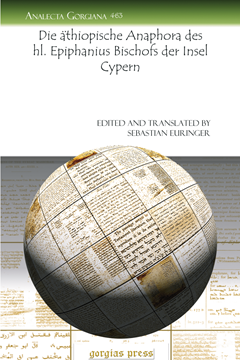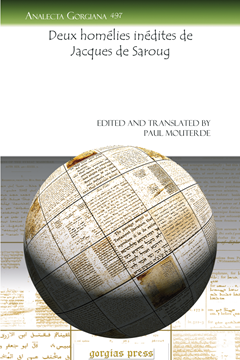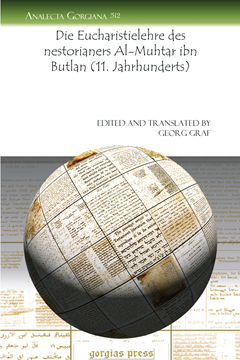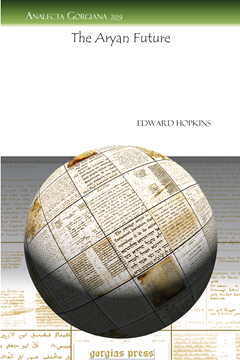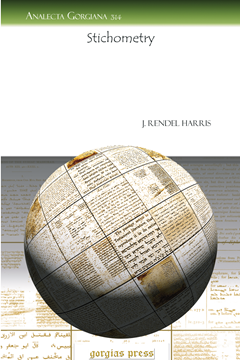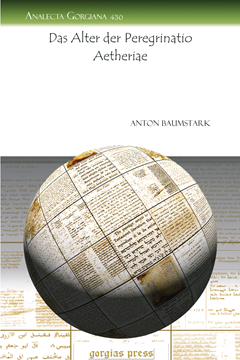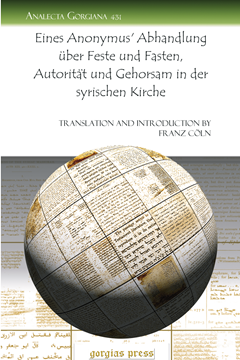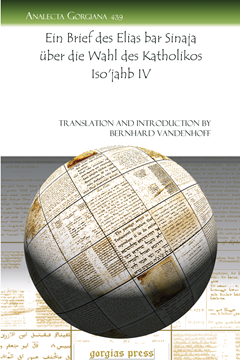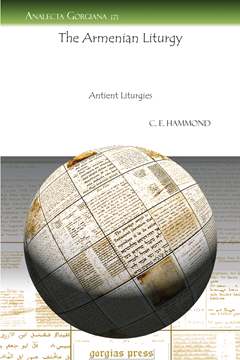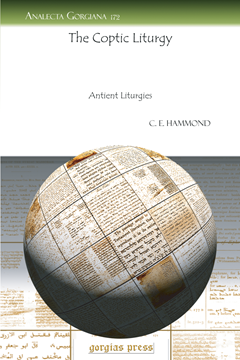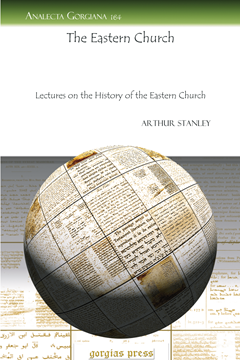Analecta Gorgiana
Analecta Gorgiana is a collection of long essays and short monographs which are consistently cited by modern scholars but previously difficult to find because of their original appearance in obscure publications. Carefully selected by a team of scholars based on their relevance to modern scholarship, these essays can now be fully utilized by scholars and proudly owned by libraries.
Die äthiopische Anaphora des hl. Epiphanius Bischofs der Insel Cypern
Edited and Translated by Sebastian Euringer
Series: Analecta Gorgiana 463
ISBN: 978-1-60724-916-0
In the present article, Sebastian Euringer publishes the Ethiopic text of an anaphora attributed to Ephphanius, the Bishop of Cyprus, and accompanies the text with a German translation and a textual apparatus including variant readings.
$41.00 (USD) $24.60 (USD)
Deux homélies inédites de Jacques de Saroug
Edited and Translated by Paul Mouterde
Series: Analecta Gorgiana 497
ISBN: 978-1-60724-975-7
This volume contains the Syriac text, with French translation, of two previously unedited homilies from Jacob of Sarug: “On Mary and Golgotha,” and “On Strangers and their Burial.”
$41.00 (USD) $24.60 (USD)
Die Eucharistielehre des nestorianers Al-Muhtar ibn Butlan (11. Jahrhunderts)
Edited and Translated by Georg Graf
Series: Analecta Gorgiana 512
ISBN: 978-1-60724-991-7
Georg Graf publishes here an edited Arabic text and German translation of a “Treatise on the Eucharist” attributed to Abu l-Hasan al-Muhtar ibn Butlan. Graf supplements the text with an introduction and brief notes.
$41.00 (USD) $24.60 (USD)
Establishment and Extension of the Law of Thurneysen and Havet
Series: Analecta Gorgiana 347
ISBN: 978-1-60724-601-5
Horton-Smith presents a defense of the Law of Thurneysen and Havet, which describes changes in Latin vowels during the 3rd and 2nd centuries BC.
$41.00 (USD) $24.60 (USD)
The Latin Prohibitive
By H. C. Elmer
Series: Analecta Gorgiana 342
ISBN: 978-1-60724-596-4
Prof. Elmer re-evaluates common misconceptions surrounding the use and meaning of the Latin prohibitive subjunctive.
$41.00 (USD) $24.60 (USD)
The Aryan Future
Series: Analecta Gorgiana 329
ISBN: 978-1-60724-587-2
Edward Hopkins, a famous scholar of comparative linguistics, compares the features of the future tense in languages of Aryan (Indo-European) origin.
$41.00 (USD) $24.60 (USD)
Stichometry
Series: Analecta Gorgiana 314
ISBN: 978-1-60724-546-9
James Rendel Harris uses known statistics of ancient autographs (that is, the original version of a written document) to posit the general appearance of ancient documents in their original form.
$41.00 (USD) $24.60 (USD)
The Tale of Gyges and the King of Lydia
Series: Analecta Gorgiana 376
ISBN: 978-1-60724-625-1
Kirby Smith explores varying 5th and 4th century BC accounts of the life and demise of Gyges, best known from Herodotous' History.
$41.00 (USD) $24.60 (USD)
Neue griechisch-saïdische Evangelienfragmente
Edited with an Introduction by Joseph Heer
Series: Analecta Gorgiana 435
ISBN: 978-1-60724-772-2
Joseph Michael Heer discusses the philological, text-critical, and liturgical value of five parchment pages containing the resurrection narratives from the Gospels of Mark and Luke in parallel columns of Greek and Sahidic Coptic and provides a transcription of the texts.
$41.00 (USD) $24.60 (USD)
Das Alter der Peregrinatio Aetheriae
Series: Analecta Gorgiana 430
ISBN: 978-1-60724-736-4
Anton Baumstark discusses the critical issues in the dating of the text of the Peregrinatio of Egeria. After comparing the account with other texts, Baumstark concludes in favor of the traditional fourth-century date and provides needed support for this conclusion.
$41.00 (USD) $24.60 (USD)
Eines Anonymus' Abhandlung über Feste und Fasten, Autorität und Gehorsam in der syrischen Kirche
Translation and Introduction by Franz Cöln
Series: Analecta Gorgiana 431
ISBN: 978-1-60724-737-1
Franz Cöln publishes here an anonymous treatise that deals with the topic of church authority from the perspective of the Syriac tradition. Cöln publishes the Arabic text of the treatise and includes a Latin translation and a brief introduction.
$41.00 (USD) $24.60 (USD)
L'Octoëchos Syrien
Series: Analecta Gorgiana 438
ISBN: 978-1-60724-775-3
Oriental liturgical experts Jules Jeannin and Julien Puyade survey the historical development and musical features of the Greek Octoechos musical tradition as it was adopted, adapted, and utilized in the Syriac tradition.
$41.00 (USD) $24.60 (USD)
Ein Brief des Elias bar Sinaja über die Wahl des Katholikos Iso'jahb IV
Translation and Introduction by Bernhard Vandenhoff
Series: Analecta Gorgiana 439
ISBN: 978-1-60724-776-0
Bernhard Vandenhoff publishes here a German translation of the letter of Elias bar Shenaya in which he publicly denounces the election of Catholicos Isho’yahb IV. In the introduction, Vandenhoff also briefly describes the historical circumstances that produced the letter.
$41.00 (USD) $24.60 (USD)
Words of Speaking and Saying in the Indo-European Languages
By Carl Buck
Series: Analecta Gorgiana 370
ISBN: 978-1-60724-657-2
Carl Buck examines the wide range of words of speaking found in Indo-European languages.
$41.00 (USD) $24.60 (USD)
Die Evangelienexegese der syrischen Monophysiten
Series: Analecta Gorgiana 413
ISBN: 978-1-60724-690-9
Anton Baumstark presents a historical survey of the development of the exegetical methods of the Syriac Orthodox (“Jacobite/Monophysite”) tradition. Baumstark conducts this survey by detailing the influence of various exegetical works through three distinct historical periods.
$41.00 (USD) $24.60 (USD)
Law Code of the Kretan Gortyna (I and II)
Series: Analecta Gorgiana 202
ISBN: 978-1-60724-431-8
A discussion of the Gortyn law code, one of the earliest known in the Greek world. This is an edition, translation and commentary on the Gortyn law code with introduction.
$41.00 (USD) $24.60 (USD)
The Armenian Liturgy
Antient Liturgies
Series: Analecta Gorgiana 171
ISBN: 978-1-60724-186-7
C. E. Hammond's Antient Liturgies provided a valuable resource at an early stage in comparative liturgical studies. Free of extensive critical apparatus, Antient Liturgies presents a collection of historic forms of worship from the Western, Eastern, and Oriental Churches. This extract from the book focuses on the Armenian liturgy. With a beginning in the early fourth century, in connection with the Exarchate of Caesarea, this liturgy is presented in English. As an analytical introduction this early study continues to provide a broad overview of early Christian worship made available in an accessible and convenient format for students and scholars.
$41.00 (USD) $24.60 (USD)
The Coptic Liturgy
Antient Liturgies
Series: Analecta Gorgiana 172
ISBN: 978-1-60724-187-4
C. E. Hammond's Antient Liturgies provided a valuable resource at an early stage in comparative liturgical studies. Free of extensive critical apparatus, Antient Liturgies presents a collection of historic forms of worship from the Western, Eastern, and Oriental Churches. This extract from the book focuses on the Coptic liturgy. The origin of the liturgy goes back to the St. Cyril and St. Basil liturgies. Here the liturgy is presented in Latin. As an analytical introduction this early study continues to provide a broad overview of early Christian worship made available in an accessible and convenient format for students and scholars.
$41.00 (USD) $24.60 (USD)
The Eastern Church
Lectures on the History of the Eastern Church
Series: Analecta Gorgiana 164
ISBN: 978-1-60724-179-9
Extracted from Arthur Penrhyn Stanley’s Lectures on the History of the Eastern Church, this initial essay lays out his general perceptions of the Eastern Church. He considers the divisions of the church, the historical epochs into which it falls, and the general characteristics and the advantage of studying them.
$41.00 (USD) $24.60 (USD)
Three Bronze Tripods Belonging to James Loeb, ESQ.
By George Chase
Series: Analecta Gorgiana 288
ISBN: 978-1-60724-517-9
Chase describes three tripods found in Etruscan tombs and discusses the extent to which they represent Etruscan adoption of Greek tripod-offering customs.
$41.00 (USD) $24.60 (USD)
The Burning of the Opisthodomos at Athens.
Series: Analecta Gorgiana 238
ISBN: 978-1-60724-467-7
In this paper William Dinsmoor, a historian of architecture and one of the scholars involved in the rebuilding of the Acropolis in the early 20th century, here uses a variety of evidence to set a date for this burning.
$41.00 (USD) $24.60 (USD)
A Greek Fragment of Tatian's Diatessaron from Dura
With Facsimile, Transcription and Introduction
Series: Analecta Gorgiana 2
ISBN: 1-59333-368-4
Discovered in 1933, a fragment of Tatian’s Diatessaron is published here with critical apparatus, a facsimile, and a transcription. The fragment, a discarded portion of a scroll with 14 surviving lines of text, was likely used in the worship of a third century C.E. chapel excavated at Dura Europos.
$41.00 (USD) $24.60 (USD)
Bardaisan and the Odes of Solomon
Series: Analecta Gorgiana 46
ISBN: 978-1-59333-860-2
A compelling discussion of the origins and authorship of the Odes of Solomon, this work provides great insight into the person of Bar Daysan as well as the research surrounding the text of the Odes of Solomon.
$41.00 (USD) $24.60 (USD)
The Descent of Christ in the Odes of Solomon
Series: Analecta Gorgiana 51
ISBN: 978-1-59333-866-4
This title explores the implications of the Descent of Christ in the twenty-third Ode in regards to astrology and Gnostic thought and supports the thesis of the author’s earlier work that the Odes emerged from a Judaeo-Christian, Mesopotamian setting.
$41.00 (USD) $24.60 (USD)
Ascetic Strains in Early Judaism
Series: Analecta Gorgiana 53
ISBN: 978-1-59333-868-8
Reviewing the relevant Jewish and Christian literature the author demonstrates that though there is no mandate for ascetic practice within early Judaism, there is a deep respect there for an ascetic way of life.
$41.00 (USD) $24.60 (USD)

